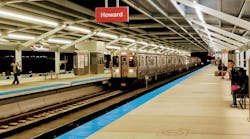CTA’s new Red-Purple Bypass begins service Nov. 19 on Brown Line
The new Red-Purple Bypass, the first major improvement for Chicago Transit Authority (CTA) customers as part of historic $2.1 billion Red and Purple Modernization (RPM) Phase One project, began service on the Brown Line Nov. 19, 2021.
The bypass is the first new section of track added to the CTA system in 28 years. RPM is the largest reconstruction project in CTA history, modernizing and replacing 100-year-old rail structures and stations to improve rail service reliability, comfort and convenience for CTA customers.
The new Red-Purple Bypass is an important part of CTA’s work to improve Red Line service throughout the region. The bypass eliminates a 114-year-old rail junction that had become a chokepoint for service across the CTA rail system and will allow CTA to add rail service during busy travel periods and reduce overcrowding and delays.
The bypass is the first major piece of work completed during Phase One of RPM, a transformational project that is rebuilding century-old rail structure and CTA stations, improving the reliability, comfort and convenience of CTA service for decades to come.
“I am pleased to be able to deliver on our promise of more reliable service to CTA rail customers,” said CTA President Dorval R. Carter, Jr. “We are continuing to work hard on modernizing the Red Line through remaining RPM work now in progress, as well as continuing to pursue funding for the new Red Line Extension Project.”
RPM is the latest project to modernize the Red Line, CTA’s busiest line that serves more than 30 percent of all rail customers.
Benefits for customers, local community
The new Red-Purple Bypass carries Kimball-bound (northbound) Brown Line trains over north and southbound Red and Purple Line tracks just north of Belmont station. It replaces the antiquated “Clark Junction” that was built in 1907 to connect what was then the Ravenswood Line (today called the Brown Line) to the Red and Purple lines, which began rail service in 1900.
Benefits of the bypass include allowing CTA to add trains during the busiest commute periods and eliminating capacity restrictions on CTA that were caused by the antiquated rail junction. The bypass will also provide quicker, more reliable service because Kimball-bound trains and Red and Purple trains will no longer have to stop and wait for each other to cross the junction.
The new project has benefits for the community, including noise walls that reduce noise at the street level; tulip-design columns; a wave pattern on the noise walls to soften the look of the structure; and lighting and street pavers to improve the street-level aesthetic.
Next: North Belmont Red-Purple reconstruction
Following completion of the bypass, CTA will demolish, rebuild and realign the 100-year-old Red and Purple Line tracks between Belmont station and W Cornelia Ave. The Red and Purple tracks north of Belmont are more than a century old and contain a curve that slows train speeds.
By rebuilding these structures, CTA can increase train speeds and improve service reliability and comfort. Along with the bypass, this improvement will allow CTA to run more trains during rush hour to reduce overcrowding. The project also benefits the community because the new track structures will be “closed deck” with noise walls, which means a quieter CTA for neighbors and pedestrians. This work is expected to begin early next year and continue through 2024.
RPM Phase One
The entire RPM program includes rebuilding all Red and Purple Line track structures and stations from Belmont to Linden in Wilmette. Because of the scale of work, RPM will be completed in phases. RPM Phase One Project includes three major components:
- New Red-Purple Bypass construction followed by the reconstruction of Red and Purple line track structure between Belmont and Newport/Cornelia.
- Reconstruction of the Lawrence, Argyle, Berwyn and Bryn Mawr Red Line stations into larger, 100 percent accessible stations and replacement of track structure. That work began in spring 2021 with new stations expected to open by the end of 2024.
- Installation of a new signal system on 23 track miles between Howard and Belmont that, similar to roadway traffic signals, will improve train flow and service reliability.




